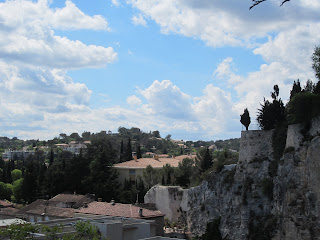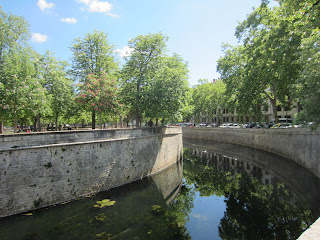 |
| Nîmes, France |
Our first hostel was booked for Nîmes, France - an ancient city from the Roman empire. When we got off the train, I went to check the gare routière (bus station) for the times to go to Pont du Gard early the next morning (the drawing attraction for our trip to Nîmes area). I had our itinerary for the week carefully planned out, and I wanted to be sure all would go according to plan. Of course, though, as with all plans of mice & men, reality had a different agenda.
What slipped my mind is that the French observe "le 1er Mai" (May 1) as the "Fête du Travail", Labor Day. Naturally I behaved very rationally -- I spent the first half hour triple, quadruple checking the schedules and cursing the French for canceling the buses on a holiday. Are these days not intended for sight-seeing and travel?
After a letting me do a little grumbling, Matheus reminded me to relax. We specifically designed this vacation for enjoying la vie à la française, not to have packed and stressful touristy agendas. So, we picked up our bags and found the bus to go to our hostel.
The next feat was more anticipated. This hostel had few reviews, but the only real complaint was that the hostel was a long walk from the bus stop. This was not an exaggeration. After 15 minutes walking uphill with my adventure pack, I thought I might die. Fortunately, this was not the case, and we were able to leave our bags behind at reception (the rooms were not yet ready). It was a bit like a walled campsite, with common spaces and cabins. There were trees all around, making it a relaxing environment.
We hiked back down the hill (down is better than up), and climbed aboard the bus back to town. The Roman presence in Nîmes is incredibly tangible; one of the most well known attractions is the ancient arena. Built in the second century AD, it is considered the best preserved Roman arena. It not as big as the colosseum, but it shares its history of bloody games and executions.
Entrance to the arena included an audioguide (one that was rather prone to falling of the cord that you put around your neck, but surprisingly durable after falling a few times onto the hard stone of the arena). It presented information about the arena such as the construction, the events of a specific day, the fights, and the people involved. It described the horrors of the history with interesting details, mentioning that the arena was filled with sand, which could easily be turned over and would soak up the blood from combat. The guide explained the customs of the gladiatorial battles, such as the different hand signals from the governor about whether the gladiator should live (if he fought valiantly) or die (if the crowd found him to cowardly). It was a rather gruesome reminder of the ugliest part of Roman history. The stories were of gladiators vs beasts, gladiators vs gladiators, and prisoners' and Christians' executions. Finally, there was an explanation of the arena's current use. Today, bullfights occur in the arena and are very popular.
After the arena, we continued exploring the town. It was a charming little city. We enjoyed an afternoon drink in the sun outside the Maison Carrée, a temple built by Augustus and dedicated to his two sons, Caius and Lucius.
As it got later, we hurried to the local grocery store and had a race against time as we picked up supplies for our picnics. The workers glared at us while we used every last minute before closing to decide on interesting meats and cheeses and vegetables for our sandwiches (the stores would not be open tomorrow!).
The next day, Fête du Travail, we spent as the French would. We spent the morning sleeping in then playing cards. In the afternoon, we ventured down to les Jardins de la Fontaine.
Because it was a holiday, the buses were not running, so we walked down the marvelous (they're always marvelous when you're walking down) hills to the park, with excellent views the whole way.
The garden was magnificent, and the gorgeous weather only helped. The sunshine and fresh air was a great change of scene after our rainy parisian weekend.
The gardens were built in 1745 by King Louis XV around the city's spring, Nemausa, which it was known for and what attracted settlers in the Roman times. The spring spread in many directions, running all over the park.
The park was built after the rediscovery of the Roman remains of the temple of Diana. This structure was old and crumbling, but magnificently still standing.
There was no plastic playground at this park, but I doubt that anyone would use it if there was. Can you imagine the games you'd play if this were at your disposal, your own playground?
There were signs around forbidding climbing the structure, but none the less children were all around it playing and there were girls lying on top sunbathing.
Pas moi. Instead of laying in the sun, we began our adventure up the hills. There were many statues around the park. One part of the park included several pretty statues with beautiful stairways leading up and up.
Up we went with these stairs, stopping to take in the views and to take in air.
The French were all over, lying in the grass, sitting in the sun, talking over picnics. I can only imagine what it would be like to have a park like this in Champaign-Urbana, a place recognized well for the park districts.
Some were in couples, some in families, some with friends, and some were alone... but everyone was glad to be passing the holiday in such an uplifting place.
The purpose of our climb, besides the beauty of the place, was the ancient tower, La Tour Magne, at the top of the hill. It was a watch tower for countless rulers, empires, and wars. It had many guards crying from its heights, with many men running down its stairs to defend it. More peacefully, it was also used for telegraph communication between Bordeaux and Toulon.
It is a tall tower with stairs inside that go all the way to the top. It's very, very tall -- I can tell you, because I climbed all the endless stairs (you couldn't see the light at the end until you were five feet from it), and I felt like I would die after (this seems like a common theme with me and stairs -- perhaps I should work on that?). The top was rewarding. We could look out over hills, as well as all the monuments we had seen that day and the day before!
Our reward for all the exercise once we reached the bottom of the hill was a respite at the cafe. I reenergized with a delicious cappuccino, with a healthy dose of chantilly on top.
On our way out of the garden, we stopped at a small crepe stand and ordered two full of Nutella. We stood alongside the children who had begged their mothers, endulging in the tasty treat, before venturing out of the garden of the fountain and venturing down the hills to town and back up the hills to the hostel in the evening.
At the end of the day, I didn't mind at all the way these French people enjoy their day off. I didn't mind at all that they cancelled the buses.






















Same here in the US -- just a few days off for the bus and train drivers, a few really major holidays.
ReplyDeleteYou have answered my question about chantilly.
What a lovely place, built back two thousand years and still here. Love those clear skies!